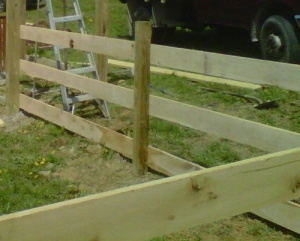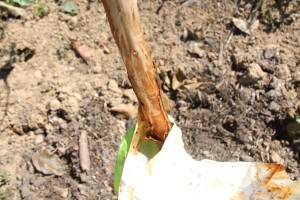They come a few times each week to our blog from all over. Questions from those wanting to know how they can protect their plants from marauding deer!

We have been fairly lucky at the farm when it comes to damage from bucks and does. For the most part – our 5’ high post and board fence has kept them from strolling through our garden. In addition, our heavy plantings of ornamental grasses and peppers throughout the landscape (low on their “love to eat list”) have never seemed to interest them.
But we are not immune from their damage. Just last fall – they destroyed our newly planted and unprotected apple trees – stripping the bark clean, and ripping the leaves to shreds.
The truth is, when it comes to deer – unless you are willing, able and ready to build some pretty high and expensive fencing – you’re going to have some damage from time to time.
With that said – there are protective steps you can take to help deter the damage deer can cause. Here are three methods that can help:
Plant Smart From The Start
The key from the beginning is to not create habitats that invite and make it easy for deer to enjoy a free lunch (or dinner).

Plants like strawberries, hostas, phlox and tulips are among the favorites of deer – so if you do plant them – plant them in areas close to the house – or that are easy to protect with a net or simple deer fence. We net our strawberries to keep out the deer and birds.
Black eyed susans, daffodils, lavender, and ornamental grasses and peppers on the other hand, are low on their “want to eat” list. This is not to say they won’t ever eat them – just that they don’t prefer them. Remember that a hungry deer, like a hungry human – will consume almost anything.
We also place plants attractive to deer in their own secluded areas. A great example of this is our popcorn crop, which deer love! We plant it away from the regular vegetable garden – so if they do find it – they will only get the corn and not the other vegetables. To protect it even better – we plant it right behind a stand of ornamental grasses and peppers. It’s not fool-proof – but it does provide better protection than simply putting it in a row in the garden.
FENCING:

Fencing is the only true way to keep deer away from plants. The problem is, to do it correctly – it can be expensive and not all that attractive. Most are surprised to find how high you have to build it! Deer fencing has to be at a minimum of 8’ high to become totally effective – and for most – it’s just simply cost prohibitive.
Electric fencing can work as well – but again – you need the wires to be high and the shock to be high as well.
Fencing, however can be used in smaller areas and smaller heights to be effective. Most deer will not jump into smaller confined areas – so a simple metal post and wire fence can do a reasonable job protecting small vegetable or flower garden plots.
Using Netting To Protect Small Trees, Shrubs and Plants

Another way to protect small trees and shrubs is with less expensive deer netting. For us – simple deer netting has worked well to protect our young trees in the orchard. You can buy a 100’ x 7’ roll of deer netting for around $35 – and its enough to do about (10) 6’ trees.
We place a few stakes on either side to support the netting – and then wrap it around the entire tree to protect it. The loose netting makes it hard for deer to get at the plants.
For small shrubs – just cover completely in the loose netting – making it hard for the deer to get at the delicate leaves they love to eat. The same goes for small plants like strawberries and hostas.
A simple draping of deer netting makes it hard for the deer to get to the tender plant leaves or fruit.
SPRAYS:
You can also use a variety of homemade sprays to deter deer from your plantings.
Deer, like humans, don’t like to munch on foul-smelling or tasting food – and spraying the foliage of plants can really keep damage to a minimum.
The key here is to reapply every week or two – and after any hard rain. Here are two sprays that have been proven to be effective:
Egg Spray:
A solution of 20% fresh eggs and 80% water is a widely know effective deer deterrent.
Mix up the eggs and water in a blender and apply with a pump sprayer to the foliage of trees and plants – making sure to cover areas high enough where the deer can reach.
One word of caution though – it’s for a sprayer to become clogged with the egg spray, so you may need to clean the tip a few times during applications.
Hot Pepper Spray:
Hot pepper spray is another well-known effective spray when combating deer and other foragers.
Although many hot peppers can work for this – habanero’s work great for this! As for solution strength – 1 cup of diced habanero’s to 8 cups of water is a good rule of thumb.
Blend them together, let the mixture steep for a day or two, and then strain and apply with a pump sprayer. Be careful when spraying – if the mixture gets in your eyes or skin – it can be very painful.
Last but not least – remember that prime time for deer to look for food is through the late fall, winter and early spring months – when nature is less likely to provide for them.
It is during these times you will need to be more diligent about protection.
If you would like to receive our DIY & Gardening Tips every Tuesday – be sure to sign up to follow the blog via email in the right hand column, “like” us on Facebook, or follow us on Twitter.
Happy Gardening – Jim and Mary!




